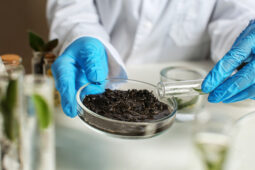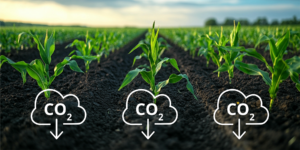Blog Series Part 3 of 3: Trust but Verify Quality Standards
The market for agronomic microbials is still fairly new and it’s changing rapidly. According to Markets and Markets, the agricultural biological industry is currently estimated at $12.9 billion USD and is projected to grow at a CAGR of 13.7% in the next five years, with the U.S. as one of the largest consumers globally. Because of this rapid growth, and the fact that this is a highly specialized and technical space, the industry is challenged to keep up with standards and regulations.
Microbes are too small to see. Therefore, selecting a quality product is more challenging than buying seedlings or livestock that can be visually inspected for health and identification. How can growers be sure that the microbes are alive and well before they purchase? BiOWiSH is leading the way towards a market which makes these decisions easy on the grower and holds the entire industry to a higher standard of quality. The work BiOWiSH is doing is not limited to the United States, but around the globe, establishing new regulations that ensure quality for growers in several other countries.
How to Know if You’re Getting a Quality Ag Microbial
It’s no secret that the agronomic microbial industry has had some struggles with quality over the years, as past industry studies have called out. Not all microbial products live up to their promises. From state regulators to academics, numerous watchdog groups have called out the abundance of agronomic biologicals that contain no microbes, too few microbes, or microbes different to those claimed on the product label. This kind of quality failure can be caused by several different factors, including:
- Poor manufacturing practices. A manufacturer of a microbial product has several jobs. Among these are ensuring that only the microbes claimed on the product label are blended into the finished product, and careful management of manufacturing and fermentation processes to ensure that no unwanted contaminants are introduced to spoil the product. A failure in either of these categories can result in a product that differs in composition from batch to batch, compromising the product’s ability to deliver consistent performance and in the worst case, the product’s safety.
- Poor stability of the microbes themselves. Not all microbial cells are created equally. A bacterium going about its business as an active cell may be vulnerable to a multitude of supply chain stressors such as starvation, UV radiation, and heat stress. Fungal spores and Bacillus endospores are much hardier, but even these cells have their limitations. If the microbes in a product aren’t cut out to survive the supply chain, the chances of them making it into the grower’s hands in saleable condition is slim.
- Vulnerability of the product to contamination. Unwanted microbes in an agronomic microbial don’t just come from poor manufacturing practices: many biologicals can be spoiled by microorganisms from the environment that are able to eke out a living within the product itself. If the manufacturer doesn’t take steps to protect the product from this kind of spoilage, the result can be a swollen, moldy, and smelly jug of product in the customer’s hands.
Growers raise the question, “How do I know I’m getting what I paid for?” and rightly so. Testing microscopic organisms isn’t as easy as a grower doing their own germination test on seed, so how can they know they’re receiving a viable and effective product? This is where conscientious manufacturers can and should lead the way towards a market in which data transparency between grower and seller is the norm. A single data sheet could provide simple and clear information to answer the grower’s most basic questions about the product, including:
- How do I know that the microbes in this product are the same species claimed on the label? To answer this question, a manufacturer can share an identification of their formulated organisms from a third-party laboratory. The identification may be to the level of genus (Bacillus, Pseudomonas, Rhizobium, ) or species (Bacillus subtilis, Pseudomonas fluorescens, Rhizobium leguminosarum) depending on the method used.
- How do I know that I’m getting all the microbes I paid for? Counting or “enumeration” of microorganisms is a complicated issue. Manufacturers often enumerate the microbes in their products at the time the product is released, but that doesn’t mean the product is stable through the supply chain. A product that passed with flying colors at the time it was produced may well be below specification by the time it makes its way into the customer’s hands, especially when testing is done at ambient conditions in a laboratory that do not represent harsher field conditions. For this reason, a manufacturer should provide two types of information to answer this question: a release report showing that the product passes QC at the time of production, and stability data showing that the product is stable under relevant storage conditions throughout its claimed shelf life.
- How do I know that this product isn’t contaminated? There are many laboratory tests that a manufacturer can perform to ensure the absence of contamination in their products. Screenings for human pathogens like Salmonella and Listeria are common, but other methods can be used to cast a wider net and catch more exotic spoilage organisms. This data would be simple for a manufacturer to share with customers in the form of a third-party lab report.
Growers should feel empowered to ask the microbial manufacturer for the results of any of the tests listed above, and conscientious manufacturers would voluntarily provide this information and the data sheet to go with it, in order to ensure that the microbials are free from contamination and provide assurance that the grower is receiving a quality product. Minimum information that the test should report would be the following:
- Official identification of the microbial species
- Colony Forming Unit (CFU) count (number of living microbes within the sample) which meet or exceed the manufacturer’s label claim
- Stability data showing label claim agreement throughout the supply chain.
- Contamination screening showing an absence of unwanted microbes in the product.
The responsibility for this kind of data transparency rests with the manufacturers of agronomic biologicals, and it’s certainly possible that all manufacturers won’t be on board. In order to hold the industry to a higher standard of quality, BiOWiSH is working with The Fertilizer Institute (TFI) to support the establishment of fair and science-based guidelines for the evaluation of label claim agreement among microbial biostimulants. As a leader of the TFI Microbiological Laboratory Methods Task Force, BiOWiSH is working with a team of industry professionals to ensure that state regulators have access to the best, most accurate tools for the job when they set about verifying the quality components listed above. One of the goals of the TFI task force is to provide a web portal for regulators and manufacturers alike to select appropriate tests and testing laboratories to carry out the appropriate methods based on the product’s label claims.
Furthermore, we’re introducing Request the Test, an easy reference guide to help growers know what information to request from their biological supplier and/or third-party testing laboratory. Download the Request the Test pdf here.
Lastly, growers should ask manufacturers or distributors to see the research. Lab studies are helpful and necessary, but practical on-farm studies will demonstrate the product’s true performance in a real-world scenario. For information on BiOWiSH agronomic on-farm studies, click here.
Making an informed decision is crucial to selecting the best ag microbials for your needs. In our three-part series, you’ve learned about identifying microbial products, considerations for ease of use, and quality verification standards. However, these things cannot replace establishing a trusted relationship with your supplier. As always, feel free to directly for exceptional personalized support!
Author
John Gorsuch
Director of R&D
BiOWISH Technologies Inc.
Cincinnati, Ohio 45208 USA





